-edible zone-
*Date: 11/15/2008
*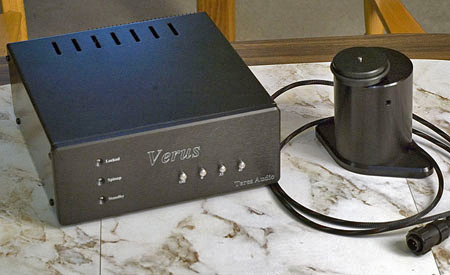
*To boot up you have to press the button marked "0"
*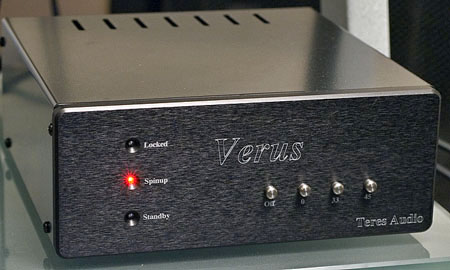
Once pressed we get to entertain ourselves by watching the platter move back and forth for a few brief but erratic seconds. Then the platter stands still. The "stand-by" LED glows yellow and the table remains motionless awaiting your next input. There is an "off" button that is to be used when we are done listening to records for the day. Otherwise the unit is designed to be left in "standby" mode thru-out the listening session.
*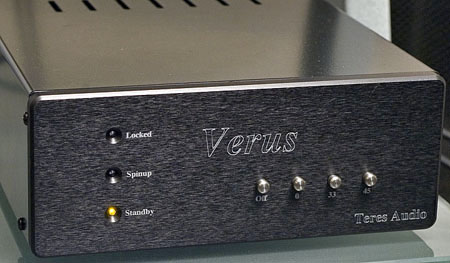
I tend to play mostly 33-1/3 rpm Lps so I will almost always push the button marked 33 to start the platter. But I could spin 45 rpm or even 78 rpm records. (Footnote 1)
*
As the platter gains speed, the 'spin-up' LED glows red. Once speed is achieved, the next LED, labeled "Locked", glows green and now we can drop the stylus into the lead-in groove.
*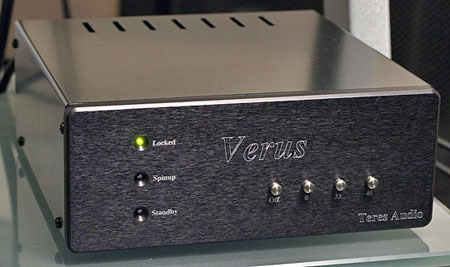
As a long time Teres owner I have to admit to some considerable
curiosity when I first saw mention, then photos, of the Teres rim drive
motor. My experience with the Teres is that whenever Chris Brady, the
principle force behind Teres Audio, has announced an upgrade within the
Teres product line, it has always been worthy of serious consideration.
As can be seen in the photos, the belt drive, whether silk cord or
vhs tape or mylar ribbon is abandoned in favor of an O-ring fitted wheel
that leans against the outer platter rim while driving it. Teres calls
it "direct coupled motor". I call it rim drive.
*
Teaser: It doesn't take a very long listen to recognize some new
sonic qualities brought about by this motor upgrade. Improvements are
apparent with regard to dynamics that are more sudden and a rhythmic
thrust that is more visceral and weighty. More about the new sonic
character further down the page.
The Teres Audio website
explains it like this:
All that is required is the ability to
position the Verus motor against the turntable platter. The Verus motor
simply leans against the platter and gravity provides the proper
pressure...".
What I see is that the motor pod weighs roughly 3
lbs and has two gel pads for feet mounted off center to the bottom
plate, allowing the off-balance mass of the pod to lean forward against
the outer rim of a turntable platter. Btw, it doesn't have to be a Teres
platter and bearing. It could be any platter of suitable dimension.
There is no need for a strobe ring or optical sensor or feedback
circuitry to measure and correct speed pitch. Pitch is maintained
entirely within the motor controller.
This motor and its
controller are derivative of the design used in the top-of-the-line
Teres Certus direct drive turntable. It is important to note that the
technology within these units is an about-face departure from the
previous DC powered Maxon precious-metal brush motor with 12v battery.
The company website describes its Verus Motor Upgrade as a "non-cogging
multi-phase permanent magnet synchronous motor" Other details about the
motor and controller include the following:
- high resolution digital drive signal synthesis
- supporting 33-1/3, 45 and 78 rpm speeds
- motor torque is adjustable 16 steps
Setting up
*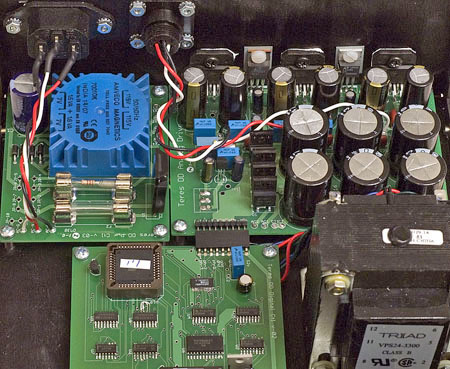
In order to get the new motor upgrade into operation within your system the controller top cover must be removed. Do this by unscrewing 8 philips-headed machine screws on either side of the case and then lift off the top cover carefully by hand.
*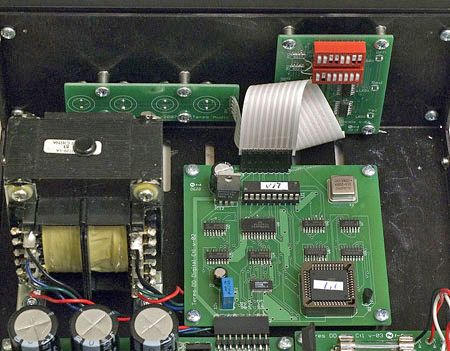
Once the cover is off an interesting assembly of circuit boards populated with a modern-day array of components is revealed. The items that we, as consumer-users, should be most interested in are the two switch banks located just behind the front panel.
*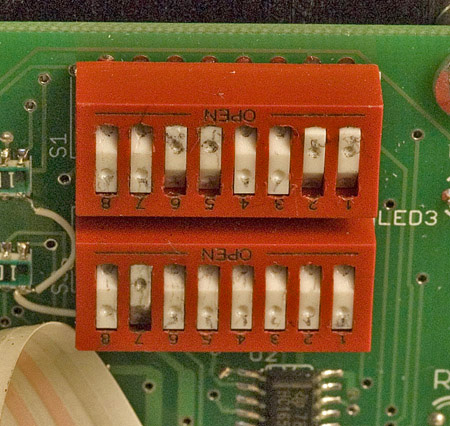
The uppermost switch bank is labled S1 on the
pcb. It will be used to adjust the spin-up rate using rockers # 5,6 and
7. The operation manual instructs us to adjust to the setting that nets
the fastest spin-up but that does not stall out the motor. As can be
seen, I have # 5 and 6 in the closed position. This is what worked for
my acrylic/lead shot loaded platter. I used a lead pencil to operate the
tiny little rocker switches. Once optimum spin-up is found we can move
on to the next setup procedure.....pitch speed.
To adjust platter
speed a strobe disk is used in combination with an incandescent light
bulb that is plugged into the wall socket. For those who haven't checked
pitch speed with a strobe disk, all you do is run the platter at speed
and shine the lamp on the strobe pattern you wish to measure. In this
case it was 33-1/3 rpm at 60 hz. When the pattern appears stationary
under the light, speed pitch is optimal.
Just below switch bank
S1 is the switch bank we will need to use for setting speed pitch. It is
labeled S2. To adjust speed pitch we can operate rockers 1 thru 8. You
can see what worked for me, every rocker open except for #7, which is in
the closed position. With this setting the strobe ring appeared to lock
stationary at 33-1/3rd rpm. Btw, Teres does not supply us with a strobe
disk. Instead we are instructed to download a free strobe pattern from
extremephono.com to be printed out on paper using our computer and
inkjet or laser printers. I had one already that I had purchased from
KAB. So I used that.
Next we adjust motor torque. To do that we
move back up to switch bank S1 and operate rockers 1-4. According to the
manual there is no "correct" setting and that this adjustment should be
made to personal taste. I experimented briefly not noticing much
difference between settings and so left things in the setting you see in
the photo. According to Chris Brady, the differences between settings
are subtle but worth experimenting with.
The O-ring: The manual
recommends the following O-ring. Mcmaster-Carr part number 9557K228.
Mcmaster-Carr describes this O-ring as being made from EPDM (Ethylene
Propylene) It's Shore hardness is reported to be: A:70. As durometer
readings go, that is not very soft. At this date McMaster sells these
O-rings in packs of 25 at a price of $5.31 per pack. The unit came with
an O-ring already installed.
There are also some cautionary
notes about o-rings and the Verus.
-
Firstly, the O-ring needs to be mounted free of any twisting so that mold line is true to the grooved wheel.
-
Secondly it is recommended that a new ring can be "trued" by holding the spinning (45 rpm) wheel with o-ring mounted lightly against a piece of sandpaper that is taped to the side of the platter. Obviously, the platter/sandpaper needs to remain stationary while the spinning o-ring lightly feeds inward against it, thus abrasively cutting the bits of mold flash and minor high points and creating a circular surface that is true and concentric to the motor axle.
-
Thirdly. It is wisely recommended by the manual that once trued, the O-ring should not be removed from the wheel.
In practice I had no problem with the O-ring and motor unit. It performed as designed throughout the review period exhibiting at all times constant speed pitch.
The signal chain:
-
Turntable: Teres 145 with acrylic lead shot loaded 27 lb platter
-
Tonearm: Graham 2.2
-
Cartridge: Shelter 501 type II MC
-
Step up trannies: 1:10 Sowter
-
stage: George Wright Wpp100C
-
Integrated Amp: Classe' CAP151
-
Spkrs: NHT 2.9
An observation:
While holding a Discwasher brush to the spinning platter to clean the surface dust from the Lp, it became apparent that there is some considerable driving force that is motivating the 27 lb platter. The brush appears not to slow the platter at all. This is one of those things any turntable owner will notice and make comparisons tol
Listening:
You can position the motor pod anywhere that is
practical about the platter. For listening impressions I chose to place
it toward the back so that it was mostly out of view. That way I could
just concentrate on the sonic character without adding any visual
distraction or reference. Then I set things up so that I could readily
change between belt and rim drive motor pods within a few moments. I
played a number of familiar Lps, tending to play a track first by one
drive then follow it up immediately by playing the same track with the
other drive. Thusly arranging a direct A-B comparison, if a little hard
on the record collection.
Being that this upgrade is a rim-drive,
I was interested that I might possibly hear some of the well known sonic
compromises common to the reputation of many idler drive turntables.
Mainly the low frequency residual noise known as rumble and then a
rolled-off upper frequency extension. Both of these faults are caused by
motor vibes making their way up into the vinyl/stylus interface.
Listening intently as I might, I could discern neither of these. The
background noise heard with stylus on spinning vinyl is as inky-black by
means of the Verus as it is via silk or tape drive. There were no
frequency roll-offs high or low. The motor operates quietly and smooth.
Throughout the 3-week long review period I could discern no sonic
trade-offs or any other negative artifacts. Below are some of my general
impressions of the new rim drive versus the Signature-2 controlled,
battery operated drive.
-
pitch steady, always
-
stronger rhythmic drive
-
Percussive sounds are more sudden and with greater impact
-
Sharper more energetic dynamic swings
-
Details, inner details are at least as good as with DC but sometimes seem better.
-
Full orchestra works are more involving
-
Small Jazz combo music seems to sound similar whether DC or Verus
-
Rock and heavy metal likes the Verus better for its weightier drive, sharper dynamic and more visceral presentation
-
Any music with a strong weighty rhythmic element, or tempo favors the Verus....obviously.
I have a Dutch EMI pressing of Pink Floyd's "Wish You Were
Here". For this review I played side one, "Shine On You Crazy Diamond".
Measuring with a Radio Shack spl meter I Allowed sound pressure levels
within the room to reach the high eighties at peak moments. At this
amplified level and during the quiet parts of the piece, background was
quiet and free of noise. Dynamic swings were rendered suddenly with
authority and slam. The drum kit, hi-hat cymbals were crisply detailed
and carried the piece forward with an intense rhythmic pace, as if to
drive the whole thing. Ambience, presence, aliveness. All very good. In
total, the presentation was involving, the conclusion inevitable and the
performance, convincing. Total immersion. It was as good as I've heard
this piece within my listening room.
To A-B compare this track
against the DC/belt Teres doesn't seem fair. The difference between the
two separate performances of the same piece is apparent. Via DC/belt,
everything just seems lighter and less intense, less involving, less
immersive.
However, when moving on to Bach the differences are
more subtle. Example:
Bach Brandenburg Concertos, English Chamber
Orchestra, Benjamin Britten, London ffrr jl42005
Side 2, No. 2 in F major, No. 3 in G major.
- Differences between silk drive and the Verus drive are less obvious
- Verus delivers a more deliberate sense of pace…but this is not hugely noticeable
- Both DC and Verus deliver excellent articulate details, pace and
tone. Both are very engaging with this music.
But with Mozart....
Symphony No. 40 G minor, Israel
Philharmonic, Zubin Mehta, London FFRR CS7068
- Differences are more obvious with Verus having a stronger sense of driving motion.
- Bass and mid-bass is weightier.
- A more deliberate pace.
- Overall sound seems fuller.
- Details are improved allowing one to identify better the individual instruments within the mass of instruments.
- Quite obvious. By comparison, DC Teres, whether it be tape or silk is the same presentation only lighter. I'm tempted to use the term 'Mozart Lite'.
Dave Brubeck seems happy with the DC driven Teres and a belt on the
"Time In" album. CS9312
First track, "Lost Waltz" starts with
Brubeck's piano leading in with a short phrase. These first few notes
waver making one sense that there is a problem with the equipment. You'd
be forgiven to expect that it is the Signature-2 Manfred circuit
allowing this proverbial wavering piano note. However, there is no
improvement when playing the same track, same notes by means of the
Verus Rim Drive. The same wavery notes. . FWIW it does it on my Thorens
too. It must be within the recording. But moving beyond that to the rest
of the record... Lost Waltz is a piece that is in fast motion with lots
of cymbals, bass drum and bass fiddle. Some of it is quite weighty when
the air movement created by the bass drum sends soft shock waves
radiating outward at floor level . (footnote
2) Yet the DC drive holds its own on this piece sounding just as
convincing, forceful, involving and detailed as does the Verus motor. Go
figure.
Teres Verus vs. the Thorens TD124
I was very much
interested in how the Rim Drive Teres compared against my current
favorite, the Thorens TD124. To keep it short the list below sums the
conditions and my observations.
- Same tonearm, cartridge and signal chain.
- Visceral rhythmic drive: comparable, similar.
- Detail extraction: Verus/Teres wins handily producing many more nuances and fine details to create a richer, cleaner, more articulate and crisply defined sonic landscape.
- The Rim Drive Teres has a "cooler" more analytical presentation while the Thorens is warmer and is at least as forceful, but softer and less defined about the edges of notes and sounds.
I think it might be apt to describe the Verus driven Teres 145 as
being a turntable capable of providing much air surrounding individual
notes, spectacular detail, inner details, tone and delicacy while also
possessing the rhythmic visceral force and sudden dynamic swing
comparable to that of a TD124.
Current owners of DC powered
Teres could expect the Verus Motor Upgrade to not change any of the
positive attributes of their Teres, which are many but then add to the
mix a more powerful sense of dynamic suddenness. At times I thought
there was slightly greater detail and inner detail while hearing the
Verus Motor in comparison to the same turntable but DC driven.
I
was looking for a flaw but could not find any. Except maybe that the
retail price of the Verus Motor and Controller is currently $1600.00
Yet, while appraising the obvious build quality and content within the
unit, it is easy to imagine that this was not an inexpensive product to
build.
Btw, the price is lower as a trade-in upgrade for current
Teres owners. Contact Chris Brady for that figure.
Conclusion:
The Teres Verus Motor is another upgrade from Teres Audio that is very
much worth your serious consideration. Recommended if you can afford it.
____________________________horizontal rule
Footnotes:
1) To engage 78 rpm the owners manual instructs us to press and release the 33 and 45 rpm buttons simultaneously.
2) Much credit goes to the NHT 2.9 side firing woofers for this sonic effect, which is satisfying.